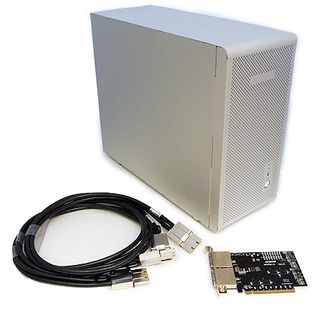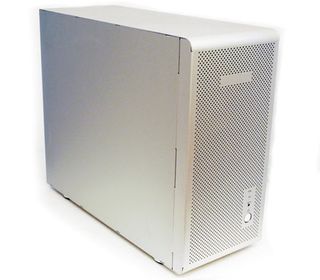External Graphics Over PCIe 3.0? Netstor's NA255A, Reviewed
Netstor sent over its TurboBox NA255A, an external enclosure capable of accommodating four dual-slot graphics cards across one 16-lane PCI Express 3.0 connection. Is this thing fast enough for general-purpose GPU compute workloads? How about gaming?
Netstor TurboBox NA255A: Space For Up To Four GPUs, Externally
Although we're starting to see more mainstream-oriented applications optimized for OpenCL, allowing graphics processors to help speed up performance, general-purpose GPU-accelerated software is still most pointedly aimed at the server and workstation space. Much of that has to do with optimizations for CUDA, which only Nvidia's GPUs support. But OpenCL is gaining traction for video editing, compression, image manipulation, and even bitcoin mining.
When all-out compute power is your priority, connecting multiple GPUs is a great way to push more performance in those apps. Going so far as getting four graphics processors working together in CrossFire or SLI can really help boost the tasks able to utilize them. And we're not talking about gaming, either. We've seen enough examples of three-card scaling tapering off, as four cards don't improve frame rates at all. No, three- and four-way setups are often the domain of power users in need of massive floating-point math.
If you're in the distinguished group of folks able to use four dual-slot graphics cards cooperatively, then you face a handful of configuration issues to overcome. What motherboard do you use? Which case do you pick? Is there a power supply with enough auxiliary connectors for the cards you're using? And how on earth do you plan to keep all of that hardware cool? Even if you get everything set up just the way you want, don't expect to have room left over for any other PCI Express-based upgrade.

But what if you could externalize all of the hardware involved, and maintain a relatively quiet host workstation? What would it take to house all of that hardware? Well, you'd need a large-enough enclosure, able to accommodate eight slots worth of back-panel I/O. You'd need a motherboard with at least four PCI Express x16 slots for the graphics cards. Power delivery would be of the utmost importance, of course. And cooling would be a lynchpin, not only for keeping four stacked boards running stably, but also for keeping the configuration quiet enough to use in the same room.

Meet Netstor's solution, called the TurboBox NA255A. It looks a lot like a mid-tower PC, but its application is far more specific. Designed to function as a PCI Express 3.0-connected expansion box, the NA255A comes with its own 1,000 W power supply and cooling fans. Its sole purpose in life is to add a quartet of PCIe x16 slots (electrically wired to run at x8 transfer rates) and two x4 slots to your list of expansion options. The whole thing is fed by a single 16-lane expansion card that drops into your host workstation, attaching externally.

One third-gen PCI Express x16 slot is able to push up to 16 GB/s per direction. Although there is overhead involved, you still get a ton of bidirectional throughput. Put differently, you can get close to the same transfer rate from one 16-lane PCIe 3.0 slot as four of the eight-lane slots commonly used to create multi-GPU arrays on Sandy Bridge-based platforms.
In theory, that's enough to game on, though this enclosure isn't really designed for the gaming market. Rather, it's intended to serve the folks looking to sling several graphics cards together for massive general-purpose GPU computing. We're interested in both possible use cases, so we're running benchmarks that apply to both segments.
Stay on the Cutting Edge
Join the experts who read Tom's Hardware for the inside track on enthusiast PC tech news — and have for over 25 years. We'll send breaking news and in-depth reviews of CPUs, GPUs, AI, maker hardware and more straight to your inbox.

The enclosure itself measures 18" x 14" x 7". It's very solid, finished in brushed aluminum with grating in the front to encourage airflow. Netstor is going for that Apple aesthetic, it appears. And for what it's worth, the TurboBox is compatible with both PCs and Macs. Because modern Mac Pros only give you one second-gen 16-lane slot and two four-lane slots, with a combined output of 300 W, it's hardly a surprise that Netstor is looking to extend compatibility to that platform as well.

One card goes into your host machine and another goes into the TurboBox itself. Cables between the two interface boards facilitate the external connectivity.

But it's what's inside the TurboBox that matters most. You'll find a Surestar TC-1000PL 1,000 W power supply, two 120 mm hot-swappable fans, a 9.5" x 11.7" PCB (NP952A-GPU), and a 6" x 4" PCIe interface card (NP970A).

Current page: Netstor TurboBox NA255A: Space For Up To Four GPUs, Externally
Next Page Setup And Overcoming Issues-
dagamer34 Now if only we could get external GPUs via Thunderbolt (or it's future iterations) so that laptops wouldn't be forever gimped, we'd be in business!Reply -
Whooo whoo, if i had the money to burn, i would get this NA255A, remove the PSU bundle, replace it with a Seasonic 1000 Platinum, slap four GTX Titans, add a custom water-cooling loop, connect it to my main PC and have (if it works) three more NA255A's for each of the PCIe for the main PC with a grand total of 16 GTX Titans for massive GPU computation. All for a grand total of $13,800. Massive electric bill, here i come!Reply
-
mayankleoboy1 PCIE signals scale poorly to long wires. So it is a technical achievement to have these signals travel over a meter of wire.Reply -
A Bad Day dagamer34Now if only we could get external GPUs via Thunderbolt (or it's future iterations) so that laptops wouldn't be forever gimped, we'd be in business!Reply
There are some external GPU cases.
The only issue is that the cheapest is somewhere slightly less than $400.
Please explain to me how an aluminum box, a micro-PSU, and a Thunderbolt-to-PCIE adapter adds up to even $200... -
A Bad Day EDIT: And when I meant the cheapest, I meant the ones that are only sufficient for a 7750. Want to pair a 7970 with a ultrabook?Reply
$400-$500 for a slightly longer box with a slightly more capable PSU. -
Vatharian Good X79 workstation mobo with 7 PCI-e slots, and 4 K20x-s on each of them. That's a TON of computing power, and if you don't want to deal with high-speed networking multiple boxes, that's nice. Of course only if this thing can actuallty work in pairs or more and in some way circumvent the 15 gpu limit in bios memory mapping. Can this thing be turned on with working machine?Reply -
adgjlsfhk ReplyBut what about someone working on a Mac Pro? Apple's more limited ecosystem means there is no such thing as a three- or four-way graphics array. This could be one of the only options for enabling multiple GPUs. If massive compute potential is important, you might need to swallow hard and consider Netstor's solution the cost of doing business in Apple's world.
Or you could use the $2000 to ditch your mac pro that is years out of date and use the money to buy a pc that is better in pretty much every way.
Most Popular

